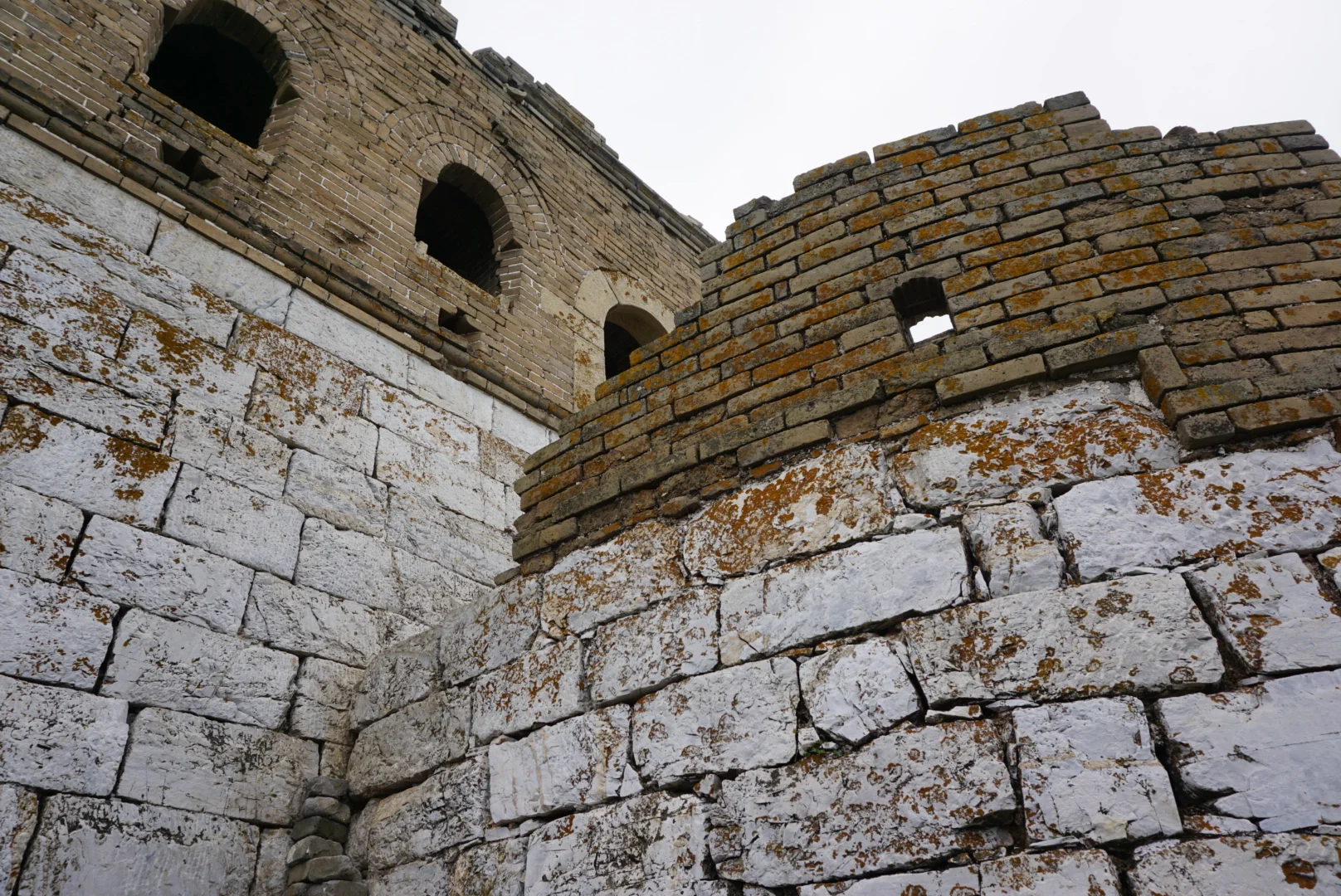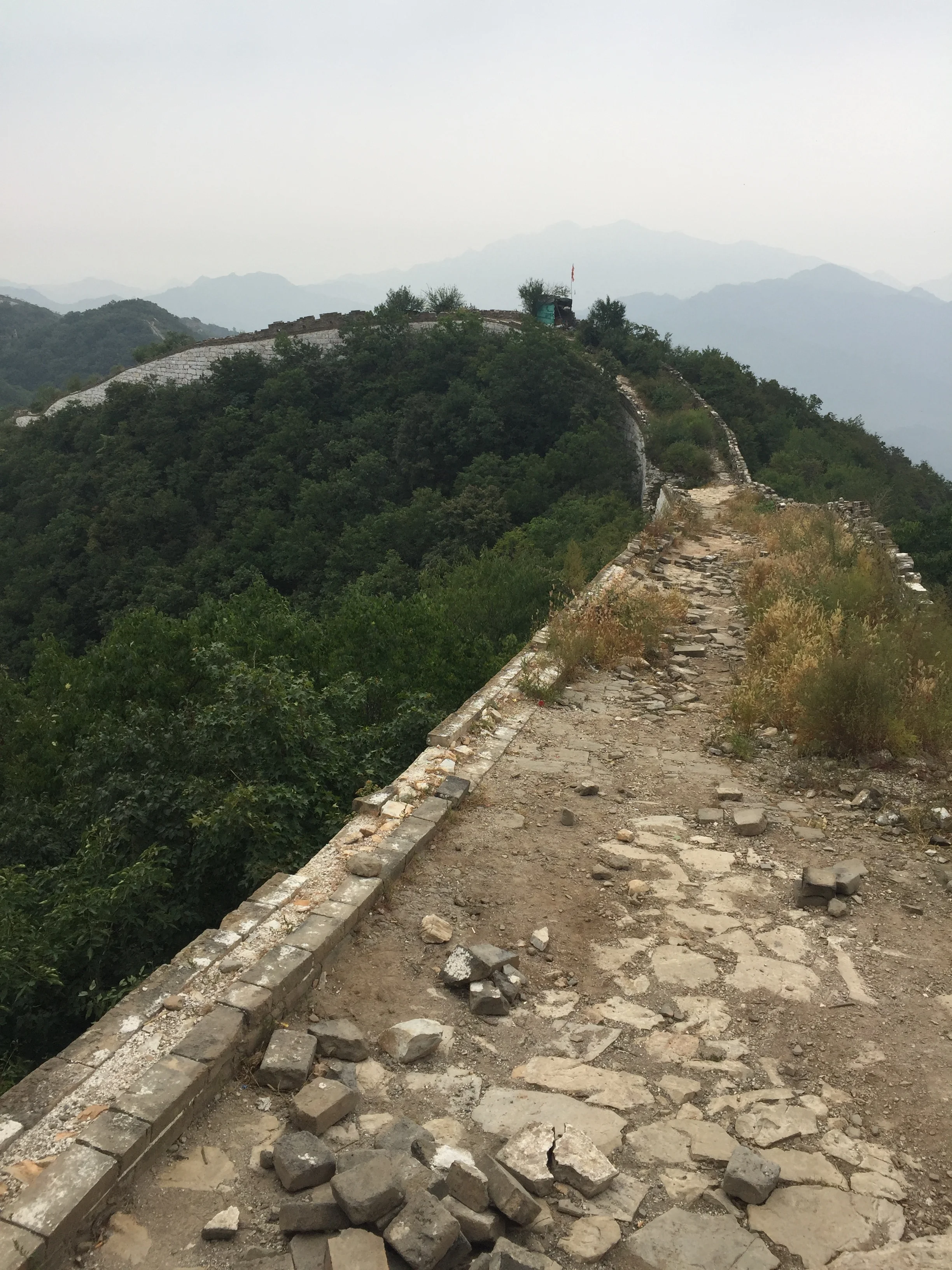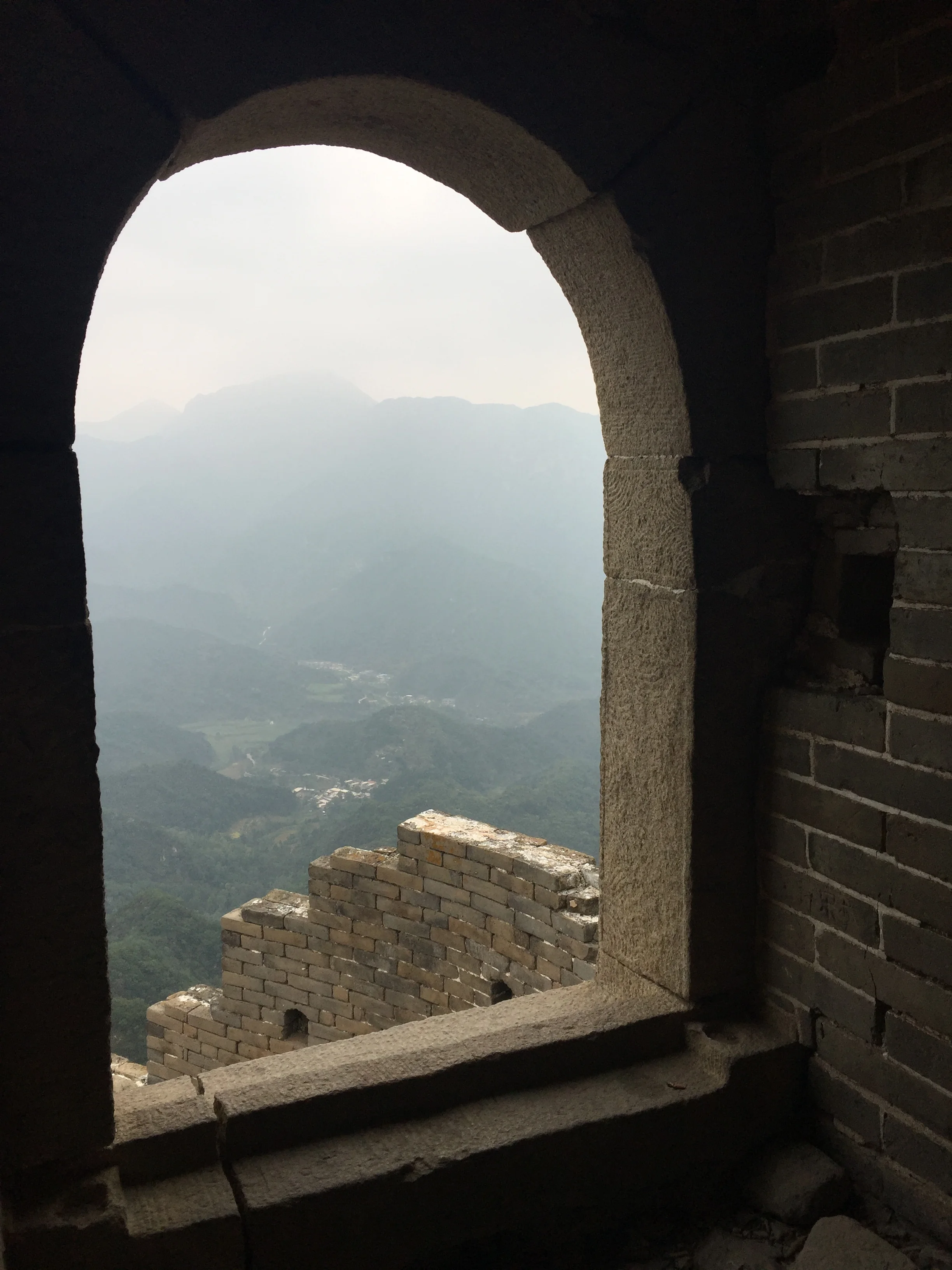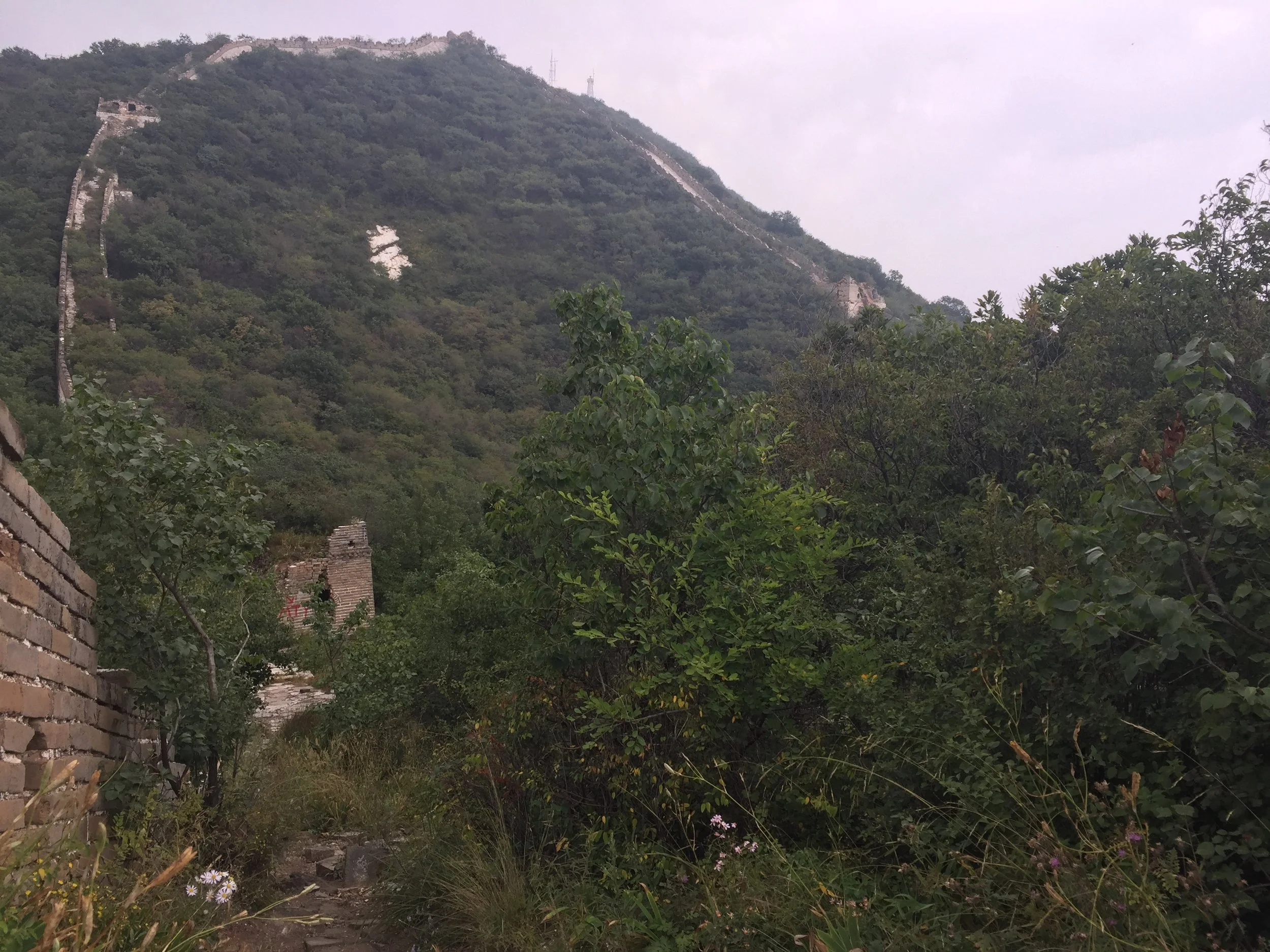The wild side of The Wall

Stepping foot on the Great Wall is an amazing experience. Getting to hike it without encountering a single soul is a nirvana.
I decided to arrange an extra-early pickup from my hotel in downtown Beijing. It was a holiday that weekend, and I wanted to beat the crowds. The two-hour drive through the sprawling city and surrounding areas gave me an idea of the sheer size of the province. Soon the city vistas transformed into foothills and mountains, covered in lush green cover and dotted with the inhabitants who farmed. Suddenly the roads became winding, hair pin turns.
The car came to a stop at a blockage in the road where two uncommonly small “micro” cars had parked side by side to prevent vehicles from passing. This was to be the starting point. The guide, who communicated with me only through a translating app on his phone, nodded at me to get out. Our first encounter with a local made it difficult to know if I was a welcome stranger or not—the signs on the way in had said, “This section of the Great Wall is closed to the public”.
She spoke quickly to the driver, looked past him at me to make an evaluation, and then turned to begin walking with us to the start of the thick brush that bordered the small town.
My excitement at finally making tracks had me nearly jogging up the trail—I was dying to see the Wall. My enthusiasm turned into awe within the first ten minutes as I looked upwards, past the foothills, all the way to the top of the mountain and caught my first glimpse. Three guard towers dotted the peaks of the mountain, connected by a rough chain of grey blocks that were clearly visible even from the bottom of the trail where I stood. It was suddenly dawning on me that the hour long hike straight up the mountain was simply the warm-up to get started on the roughly three-hour hike to Mutianyu. I was dripping sweat and thanking myself for never taking up smoking.
The trail took us through lush forest where the trees sprung up from a red tinged earth. Nothing like the blood red of African or Australian soil, but a definite signal that I was far from home. The peace and solitude of the experience began to relax me. The sound of my footsteps became a gentle metronome to my quickened, labored breathing. The effort of it all was a reward in itself—I knew that so few people would ever get the opportunity to see the Wall like this.
The steepest section of the hike was made easier by the walking pole the guide had given me. A short push to the top had us scaling steep inclines that forced us to grab at tree roots to steady ourselves and propel us upwards. We were greeted by the most amazing view of the town that we had just come from. I placed a hand at the base of the wall and smiled. This was it, this was the rare view that, every so often, gets captured by a camera lens. My awe and appreciation for the effort it had taken to build such a sprawling structure was amplified as I suddenly saw the crude stack of bricks that we were to climb in order to gain entrance. The Wall at this particular section showed a weakness—the height of the guard window was just enough that a stack of blocks and a bit of courage would allow you to scale the 30 ft. of crumbling stone to reach a guard window. This was Zhengbeilou tower, the sort of relic that pulls you back in time, the largest and most complete watchtower along this section.
My guide held the loose blocks from slipping out under my feet as I made the climb up two piles of these makeshift steps. When I chartered this guide, I wasn’t really aware that this was how we would be making our entrance. He got me safely up to the first tier and then made his climb, declining my outstretched hand and making it look easy. One more level to go—the blocks under the window were shorter than the first tier, meaning he would have to give me his shoulder to boost myself up the final bit. He was by no means a burly platform, and I was suddenly conscious of our size difference. I couldn’t believe the view from that first tower. The Wall stretched on for miles to my left up and down a steep section and zigzagged through the mountains to my right. From here I could see the Jiankou section (meaning “arrow nock” because of its pointed contour following the mountain crests) in its entirety snaking along the lush mountain range. This section was part of the original Ming Dynasty (1368-1644).
To my surprise, there were backpackers sleeping in Zhengbeilou tower. They didn’t speak English but smiled at me while they brushed their teeth and stretched out the knots that had gripped them from a night of sleeping on a cold, hard stone floor. My guide ushered me through the tower to the open portion of the wall – or what was left of it. Aside from our height above the rest of the mountain you could barely tell the trail apart from the thick foliage surrounding us. The Wall had sprouted full sized trees across the 20-foot width and was heavily carpeted in grass from decades of non-use. There were no more protective side walls, creating a sharp drop either side. The center of the path was the only portion that would hold weight with any certainty, and I dare not linger near the edges for fear my vertigo would kick in.
The guide took a few photos of me on his cell phone, which I presume was to show his manager that we did indeed make it safely to our starting point. He used his translator app again to speak to me, “Take this trail all the way to Mutianyu, then cable car down to parking lot”. That was it, those were the directions, he pointed to our left, at the sprawling first section that was a steep ascent and even steeper decent and waved at me. It was time to go. I actually laughed nervously as I realized I was heading out on my own. The hikers were headed the opposite direction. I waved to him, tightened my backpack and then marched towards the towers that dotted the distance. It was hard to say but it looked as though each tower was spaced about a kilometer apart.
In a short time, I approached the first crumbled tower. I stopped for photos about 300 meters from the entrance and my heart started racing. I could see that I had to do some climbing and navigating loose stones to get through and carry on, but suddenly I was worried there were people in there—not the friendly backpackers but perhaps squatters. Each of the towers is designed the same, with about 4 alcoves off the central hallway that were about 8 feet deep in either direction. Deep enough that as you walked through the hallway you couldn’t see what was in the alcoves until you were standing there. I decided to stop and listen for signs of life, just in case I could hear friendly laughter or pots and pans, or a recognizable accent. It quicly became my hope that I would meet no one. There were no sounds coming from the first tower so I walked quietly towards the tower, trying to talk myself out of being such a baby.
The alcoves proved to be a real heart stopper, I looked left and right quickly as I passed through each one, hoping that I was alone and wanting to get back to the comfort of the wide open wall. The dilapidated towers made for some precarious footwork. Making it through the first tower boosted my confidence. I had a really lovely climb up the tallest portion of the Wall that I would touch that day. The tower at the topmost peak was in far worse condition than the others and I had to scale the outside ledge of the tower to get to the other side and keep walking. The inner portion of the tower had caved in and revealed a hollow that was far too deep to climb out of and would have certainly caused some broken bones if I fell it. I regret not taking any pictures inside the towers, but in hindsight it was uncomfortable and unnerving being inside them and I rushed in and out of each one.
The day was proving to be humid and slightly overcast, which really tested the limits of my camera with the hazy lighting. I thanked my good fortune that it wasn’t rainy as I could imagine the smooth stones and dusty earth that covered the wall would become slick like ice at the introduction of even a small bit of moisture. I really didn’t wear the best shoes for the journey, but to be fair I hadn’t realized the sort of adventure I would find myself in. I was enjoying the challenge of the hike, the careful footing that was required, and the emotion that comes when you see a manmade creation of this magnitude. Solitude, on this scale, is something I so rarely experience. Having to be self-reliant, careful, aware—these are all the same feelings that made me fall in love with hunting and scuba diving. In those moments, life is so much more easily understood.
I had to stop several times to catch my breath from the exertion of the hike. I was carrying only a few items in my pack but the heat and humidity, even in the early morning, were taking a toll. As I made it to the summit of the tallest tower (1029 meters), the Wall rounded into a U-turn and took me straight back down the crest of an adjacent mountain. The descent was dizzyingly steep, and impossible to properly capture in a photo. This portion of the wall was in a little better condition, which wasn’t really a help at all since the smooth stones had a thick layer of fine dust that made for a surface as slippery as a newly polished floor. In the first twenty feet of the descent I thought back to my Patagonian guide in Chile explaining to us tricks about steep slope descents and tried to mimic his zig-zagged shuffles, keeping my weight centered over my feet and trying not to lean too far on my heel-side. It was no use, I started skating and sliding down the hill, trying to prevent myself at all costs from somersaulting forwards until finally gravity won and my feet slid out from under me, bringing my weight down hard onto the left side of my leg and crashing my hip into the stones. I didn’t even have time to get a hand out to take some of the fall—maybe this was a good thing since I have more cushion in my rear than I do strength in my wrist. I was shaken, hurt. I couldn’t help it—my legs were now trembling from the adrenaline and the pain. I could tell that this fall could have been worse, and that I was going to be OK, but my confidence was plummeting and I began worrying about the other 500+ meters below me that offered the same terrain.
I made the smart choice, the only choice really, and got down on all fours to spread out my weight, facing the Wall. It was then I realized how stupid it was for me to have attempted walking down face first. In this new position I realized that I was on a thirty-degree incline, and could easily have slid the entire way down if I was really unfortunate. Even facing the Wall, I had a few moments of nervously digging my hands and feet into nooks and crannies like a cat with outstretched claws to stop myself from sliding. A few times I turned around to face downhill and evaluate whether or not I could resume walking normally but then immediately opted for my Spider-Man stance to ensure I left with only bruises and not broken bones.
Whoever engineered this section obviously had only performed “back-of-a-napkin” type calculations. How the F*** did the previous inhabitants scale this daily?
Still, I hadn’t bumped into any hikers and was feeling very isolated. Being that I had not had much interaction with my driver/guide before departing, I wasn’t exactly sure how long this hike was supposed to take. I jogged a few sections, enjoying the scenery and trying to shake out the stiffness that was developing on my left side from where I fell. I had lost count of how many towers I had climbed through, but was starting to notice the condition of the wall was improving the further I went. The vistas were spectacular and I was glad I had made the trek extra early to ensure any looming cloud cover wouldn’t affect my pictures.
Finally, I heard the chattering of an approaching group. Definitely not an English-speaking group but they sounded upbeat and friendly. I saw the woman first, followed by three of her male friends. Judging by their clothing and shoes they had simply hopped the new fence at Mutianyu and gone for an “adventure”. I knew I was getting close to the touristy area now. The pathway had leveled and the side walls had become noticeable, keeping me from any worry of falling over the edge like when I had begun the trek. The ornate features began to show, such as openings halfway up the wall for lookouts and weapons to protrude while keeping the defender safe from attack.
The next person I saw was a smiling Chinese woman who immediately offered me water from a small cooler she had filled with sealed bottles of water and beer. She spoke very good English, and I stopped to have a chat, relieved to be back in the safety of civilization. She told me I had about forty minutes to go to Mutianyu tower 14, my descent point. I unpacked the delicious loaf of sweet, apple-filled bread the driver had given me and shared some with her, happy for the company and wanting to thank her for the information. She accepted it and we laughed a little as she asked me how many people I was with. I held up a single finger to indicate I was alone.
She called me brave. I thought it funny that I would find so much pride in such a simple compliment but I couldn’t help feeling brave at that moment. I could tell I was through the toughest portion of the hike. I thanked her for the water and said goodbye as I headed East.
I arrived at Tower 20, and just as I had been told, was confronted with a newly built wall that was intended to keep people from Mutianyu heading west to the closed portion of the Wall. I threw a leg up—waaaay up—and was greeted by an audience of curious tourists as I pulled myself up the top of the six foot wall. It was funny seeing people in dresses and suit jackets. At this point I was sweat-soaked and covered in dirt from my fall. I was so glad for my experience, and almost wishing I hadn’t been so eager to return to civilization. The hike only took me about 2.5 hours once I was on the wall and seeing all the pristine sections that laid ahead made me want to turn round and scale back to my starting point. Not to say the rest of the Wall wasn’t spectacular but it definitely felt “watered down” compared to the raw experience I was just enjoyed. The cable car at Tower 14 came quickly—the walk was easy and devoid of obstacles.
The cable car down to the parking lot gave me my last glimpses of the Wall and I snapped a few extra photos to gain a few extra vantage points for the album. What an extremely fulfilling experience to have the Wall all to myself for a couple of hours.





